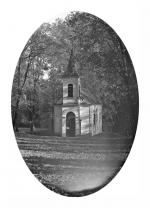|
Kodak N° 4 Cartridge (mod. F) |
Manufactured or assembled in USA from 1899 to (Circa) 1907.
Index of rarity in France: Infrequent (among non-specialized garage sales)
Inventory number: 3017
See the complete technical specifications
Chronology of cameras Kodak
This "No. 4 Cartridge Kodak", as designated by its manufacturer, is a beautiful tourist camera, sold in tens of thousands of copies at the turn of the nineteenth and twentieth centuries. The wooden construction covered with leather is pretty neat and sturdy. The series of Kodak Cartridge No. 4 and that of model No. 5 which followed, were produced from 1897 to about 1907 and was probably offered to the public during few years later.
It is difficult to know what feature of the model 4 F presented here differs from other Kodak Cartridge No. 4. Aside from the shutter and lens, the differences were only in some few details.
The only visible change since the first 1897 version, includes two elements: (1) the lens stand that was made of wood at the origin and (2) the various fasteners and the parts involved in the focusing or shift which were previously made of brass.
The 4 F presented here has a metal lens stand and these parts are nickel-plated. This allows us to date its production as of 1899 or later. By 1899, in fact, every 4 B, 4 C, 4 D, 4 E and 4 F, came factory equipped with such metal stands and nickel plated parts. Other features, as indicated, should be details.
Less than ten years after the introduction of the roll film by Kodak in 1889, the first model of "No. 4 Cartridge Kodak" accepted 104 films (4 x 5 inch size). This Kodak Film 104 was produced until March 1949.
However, it is clear that Kodak provided at the time also the "double chassis for gelatin bromide plates " (Photo-Hall catalog), but according to the information gathered, it is in the idea of promoting the roll film that these models were designed and launched on the market.
The "No. 4 Cartridge Kodak" in its F version offers the double extension bellows, the vertical and horizontal shifts and two viewfinders integrated in the housing for taking horizontal or vertical views. There is also a spirit level. As for the cover, the back, giving access to the film, is released by sliding up, once removed a hook at the back of the bed. The roll films are retained by sophisticated systems of pins mounted on springs.
The body of the camera shows the number 330 engraved in the wood (body and bed) to probably facilitate pairing at the carpentry workshop. It contains an original roll 104 in wood, 13 cm long, with metal flanks (diameter 3 cm). There is a reminder of the name Kodak on the sides of the coil, but not the film No (since they were established later).
The leather strap itself reminds the manufacturer name and No. 4 Cartridge Kodak, without indicating the model. It's inside the black glazed bed and on the edge of the open housing that appears "Model F". On this copy, a small brass plate is nailed just below the flange indicating "Photo Office ~ M. Maillart GENEVE."
This particular unit is a reconstruction without anachronism, with contemporary and appropriate elements. The complete body, but without shutter or lens was acquired initially. The shutter with its lens had been sought and acquired soon after. This couple recomposed is echoed occasionally on illustrations related to"No. 4 Cartridge Kodak." The owner had also the choice and could decide to change a few years after the lens or the shutter/lens assembly.
In this case, the shutter is an Unicum reaching 1/100 sec., allowing manual or pneumatic triggering, as well as manual or pneumatic cocking (two bulbs and a double set of tubes were required). The lens is a 150mm Hugo Meyer C. Górliz Aristostigmat (yes:.... Aristostigmat) with a 6.8 aperture.

Interesting links or bibliography :
Add a link or element of bibliography, a picture taken with this camera, a picture of box or an ads about this camera
Your photos taken with the same camera:
Cameras from Ebay France (Kodak) (Uploaded each 3 hours)








